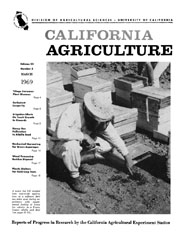


University of California
California Agriculture
|
|||
|
|||

Cover:
A severe bee kill resulted from insecticide applications to a safflower field two miles away during experiments with supplemental feeding of honey bee colonies in a Fresno County alfalfa seed field.
March 1969
Volume 23, Number 3 |
|||
|
University of California, 1301 S. 46th St., Bldg. 478 Richmond, CA
|